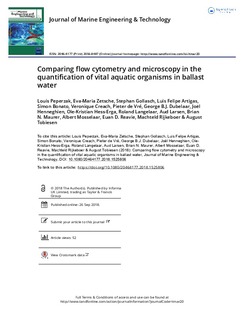| dc.contributor.author | Peperzak, Louis | |
| dc.contributor.author | Zetsche, Eva-Maria | |
| dc.contributor.author | Gollasch, Stephan | |
| dc.contributor.author | Artigas, Luis Felipe | |
| dc.contributor.author | Bonato, Simon | |
| dc.contributor.author | Créach, Véronique | |
| dc.contributor.author | Vré, Pieter de | |
| dc.contributor.author | Dubelaar, George B.J. | |
| dc.contributor.author | Henneghien, Joël | |
| dc.contributor.author | Hess-Erga, Ole-Kristian | |
| dc.contributor.author | Langelaar, Roland | |
| dc.contributor.author | Larsen, Aud | |
| dc.contributor.author | Maurer, Brian N | |
| dc.contributor.author | Mosselaar, Albert | |
| dc.contributor.author | Reavie, Euan D | |
| dc.contributor.author | Rijkeboer, Machteld | |
| dc.contributor.author | Tobiesen, August E.Dessen | |
| dc.date.accessioned | 2019-05-10T09:04:59Z | |
| dc.date.available | 2019-05-10T09:04:59Z | |
| dc.date.created | 2019-01-10T17:04:43Z | |
| dc.date.issued | 2018 | |
| dc.identifier.citation | Journal of Marine Engineering & Technology. 2018, 10. | nb_NO |
| dc.identifier.issn | 2046-4177 | |
| dc.identifier.uri | http://hdl.handle.net/11250/2597206 | |
| dc.description.abstract | The ability to quantify vital aquatic organisms in the 2–50 µm size range was compared between five different flow cytometers and several different microscopes. Counts of calibration beads, algal monocultures of different sizes as well as organisms in a Wadden Sea sample were compared. Flow cytometers and microscopes delivered different bead concentrations. These differences between the instruments became larger for algal monocultures and were even higher for the Wadden Sea sample. It was observed that the concentration differences were significant between flow cytometer and microscope counts, and that this difference increased with the size of the objects counted. Microscope counts were more accurate for larger (50 µm) objects because cytometers struggled with bigger particles that clogged the instruments. Contrary to microscopy, the flow cytometers were capable of accurately enumerating cultured cells in the 2–10 µm size range and cells in the lower size range of the 10–50 µm size class. Flow cytometers were also well-suited to assess low abundance samples due to their ability to process larger volumes than microscopes. The results were used to indicate which tools are suitable for ballast water monitoring: flow cytometry is a suitable technology for an indicative and real time analysis of ballast water samples whilst only microscopy would be robust enough for detailed taxonomical analyses. | nb_NO |
| dc.language.iso | eng | nb_NO |
| dc.publisher | Taylor & Francis Group | nb_NO |
| dc.rights | Attribution-NonCommercial-NoDerivatives 4.0 Internasjonal | * |
| dc.rights.uri | http://creativecommons.org/licenses/by-nc-nd/4.0/deed.no | * |
| dc.title | Comparing flow cytometry and microscopy in the quantification of vital aquatic organisms in ballast water | nb_NO |
| dc.type | Journal article | nb_NO |
| dc.type | Peer reviewed | nb_NO |
| dc.description.version | publishedVersion | nb_NO |
| dc.rights.holder | © 2018 The Author(s) | nb_NO |
| dc.source.pagenumber | 10 | nb_NO |
| dc.source.journal | Journal of Marine Engineering & Technology | nb_NO |
| dc.identifier.doi | 10.1080/20464177.2018.1525806 | |
| dc.identifier.cristin | 1654438 | |
| dc.relation.project | Norges forskningsråd: 208653 | nb_NO |
| cristin.unitcode | 7464,20,15,0 | |
| cristin.unitcode | 7464,20,13,0 | |
| cristin.unitname | Akvakultur | |
| cristin.unitname | Økotoksikologi | |
| cristin.ispublished | true | |
| cristin.fulltext | original | |
| cristin.qualitycode | 1 | |

